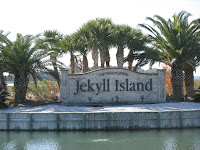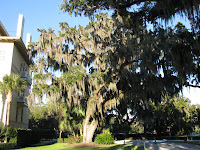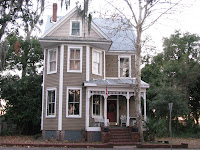Update 51: Brunswick, GA Dec. 27 to Dec. 30
Jekyll Island, one of Georgia's premier resort destinations, is one of the Golden Isles. Just past the Welcome to Jekyll Island sign and past the entrance gate towers a large road sign warns that GAS is not available on the island...be sure your tank is full. This sign will soon be outdated with the completion of a large gas station currently under construction at the island's entrance. To access the island, visitors leave the causeway and immediately pass through a collection booth where a $5 parking fee is collected.
 In 1886, the rich and famous men of the time approached the then owner of Jekyll Island and offered to buy the island for $125,000. The men were looking for a retreat. With the purchase of the island, the Jekyll Island Club came into being. A large clubhouse was built and is currently a resort hotel.
In 1886, the rich and famous men of the time approached the then owner of Jekyll Island and offered to buy the island for $125,000. The men were looking for a retreat. With the purchase of the island, the Jekyll Island Club came into being. A large clubhouse was built and is currently a resort hotel. Elaborate "cottages" for their families were also built. These club founders included: J.P. Morgan, Frank Goodyear, Edwin and George Gould, Joseph Pulitzer and William Rockefeller. This is the Crane house.
Elaborate "cottages" for their families were also built. These club founders included: J.P. Morgan, Frank Goodyear, Edwin and George Gould, Joseph Pulitzer and William Rockefeller. This is the Crane house. The green house called Moss Cottage was built in 1896. Mistletoe Cottage with the large wreath was built in 1900.
The green house called Moss Cottage was built in 1896. Mistletoe Cottage with the large wreath was built in 1900. An apartment building called San Souci housed six families. The historic area can be viewed on foot or by trolley. The trolley ride fee includes entrance into a couple of homes.
 The Jekyll Island Club stable became the museum. Today part of the stable is a museum and part has the horse carriages and tram needs. The museum is not heated and the day we visited it felt like we stepped into a refrigerator. We read very quickly. The theater and gift shop did have some heat.
The Jekyll Island Club stable became the museum. Today part of the stable is a museum and part has the horse carriages and tram needs. The museum is not heated and the day we visited it felt like we stepped into a refrigerator. We read very quickly. The theater and gift shop did have some heat.The old power plant houses the Sea Turtle Center, one of the reasons we came here. The Center provides information on turtles. The well designed exhibits are interactive and set up to teach kids of all ages about turtles. A puppet show was in progress when we arrived.
Turtles have existed for at least 250 million years, since the time of dinosaurs. In 2010, Jekyll Island counted 140 turtle nests on its shores. The total of nests for Georgia, state-wide, was 1769. Sea turtle are measured by the length of their carapace (shell). Hatchling loggerhead sea turtle measure about 2 inches, but over their lives they will grow to 20 times that size. Adult sea turtles have a shell 36 inches long and they weigh about 250 pounds.
 We found the section about turtle gender interesting. Gender is determined by the temperature around the incubating eggs. Girls are HOT! Boys are COOL! A cool area around the nest will produce males, but if the temperature in the middle of the nest is warm, females will develop. A turtle's gender cannot yet be determined until it becomes an adult at about 35 years of age. Then the female will have a wider tail. Amazingly a turtle's true age cannot be determined either. So turtles may be anywhere from 35 to over 150 years old. Also, approximately one out of 4000 hatchlings survives to become an adult sea turtle.
We found the section about turtle gender interesting. Gender is determined by the temperature around the incubating eggs. Girls are HOT! Boys are COOL! A cool area around the nest will produce males, but if the temperature in the middle of the nest is warm, females will develop. A turtle's gender cannot yet be determined until it becomes an adult at about 35 years of age. Then the female will have a wider tail. Amazingly a turtle's true age cannot be determined either. So turtles may be anywhere from 35 to over 150 years old. Also, approximately one out of 4000 hatchlings survives to become an adult sea turtle.
Turtles have existed for at least 250 million years, since the time of dinosaurs. In 2010, Jekyll Island counted 140 turtle nests on its shores. The total of nests for Georgia, state-wide, was 1769. Sea turtle are measured by the length of their carapace (shell). Hatchling loggerhead sea turtle measure about 2 inches, but over their lives they will grow to 20 times that size. Adult sea turtles have a shell 36 inches long and they weigh about 250 pounds.
 We found the section about turtle gender interesting. Gender is determined by the temperature around the incubating eggs. Girls are HOT! Boys are COOL! A cool area around the nest will produce males, but if the temperature in the middle of the nest is warm, females will develop. A turtle's gender cannot yet be determined until it becomes an adult at about 35 years of age. Then the female will have a wider tail. Amazingly a turtle's true age cannot be determined either. So turtles may be anywhere from 35 to over 150 years old. Also, approximately one out of 4000 hatchlings survives to become an adult sea turtle.
We found the section about turtle gender interesting. Gender is determined by the temperature around the incubating eggs. Girls are HOT! Boys are COOL! A cool area around the nest will produce males, but if the temperature in the middle of the nest is warm, females will develop. A turtle's gender cannot yet be determined until it becomes an adult at about 35 years of age. Then the female will have a wider tail. Amazingly a turtle's true age cannot be determined either. So turtles may be anywhere from 35 to over 150 years old. Also, approximately one out of 4000 hatchlings survives to become an adult sea turtle.The Center provides state-of-the-art emergency care for sick and injured sea turtles. A viewing window in the Center allows visitors to watch vets work with turtles. We saw two vets checking over a small turtle that had been brought in that morning.
 Behind the main building a tent structure provides the rehab facilities. A raised deck bisects the tent. This deck allows visitors to observe the five large tubs of water on each side platform to view the turtles in the pools. The pools appear to be as wide as the largest plastic kiddie pool (maybe 6 feet across), and about three feet deep. Some tubs are divided to accommodate more than one turtle. Each tub has a mirror above it.
Behind the main building a tent structure provides the rehab facilities. A raised deck bisects the tent. This deck allows visitors to observe the five large tubs of water on each side platform to view the turtles in the pools. The pools appear to be as wide as the largest plastic kiddie pool (maybe 6 feet across), and about three feet deep. Some tubs are divided to accommodate more than one turtle. Each tub has a mirror above it. Each turtle is named. Griffin is the largest and considered the oldest. Unfortunately I didn't record his information regarding size. So at a guess, his shell was close to three feet wide. He arrived at the Center with acute intestinal problems. Those problems were fixed and he still had floating problems. A CAT scan showed he had a stroke. We watched as staff member climbed into the pool to work with him. Griffin must learn to dive and feed himself. The stroke makes it hard to dive. To maintain balance a wet blanket is wrapped around his shell, and weights are added to the affected side. They coax him to dive with squid as bait. We also saw them hide his pills inside a squid to get his meds down.
Each turtle is named. Griffin is the largest and considered the oldest. Unfortunately I didn't record his information regarding size. So at a guess, his shell was close to three feet wide. He arrived at the Center with acute intestinal problems. Those problems were fixed and he still had floating problems. A CAT scan showed he had a stroke. We watched as staff member climbed into the pool to work with him. Griffin must learn to dive and feed himself. The stroke makes it hard to dive. To maintain balance a wet blanket is wrapped around his shell, and weights are added to the affected side. They coax him to dive with squid as bait. We also saw them hide his pills inside a squid to get his meds down. We observed the other turtles in the rehab tent. Many of them had floating problems. Of the 45 turtles treated 16 have been well enough to release back into the wild.
We observed the other turtles in the rehab tent. Many of them had floating problems. Of the 45 turtles treated 16 have been well enough to release back into the wild. We ate lunch at the Red Bug Motors Pizza place. Very quaint place and great pizza! Red Bug Motors rents the little electric carts to visitors for use motoring around the island.
We ate lunch at the Red Bug Motors Pizza place. Very quaint place and great pizza! Red Bug Motors rents the little electric carts to visitors for use motoring around the island. We drove both the north and south loops of the island. On the south loop we stopped at St. Andrews Park and walked out to the beach which is on the Atlantic Coastal Intrawaterway.
We drove both the north and south loops of the island. On the south loop we stopped at St. Andrews Park and walked out to the beach which is on the Atlantic Coastal Intrawaterway. The Sculpture memorial to the Wayfarer shows three metal sails rising out of the sand. Three reader boards describe the story of the ship and the people involved in the last slave ship. Fifty years after the banning of slavery, the duBignons,then owners of Jekyll Island brought slaves over and put them on the island. They tried to sell some slaves and their illegal acts were discovered. The slaves were freed and many stayed on the island..
The Sculpture memorial to the Wayfarer shows three metal sails rising out of the sand. Three reader boards describe the story of the ship and the people involved in the last slave ship. Fifty years after the banning of slavery, the duBignons,then owners of Jekyll Island brought slaves over and put them on the island. They tried to sell some slaves and their illegal acts were discovered. The slaves were freed and many stayed on the island..We did pass the Horton House, which is one of the few remaining ruins from early English colonization in Georgia. It was made of tabby. Tabby is a local building material made of equal parts of oyster shell, sand, lime and water, mixed in a mortar and poured into forms. It is cheap, strong and locally available.
The east side of the island included lovely beaches. Then at one point a small village of portable buildings/trailers came into view. They looked a lot like my portable classroom at Esquire Hills. As we passed we discovered this was town center. We saw signs indicating the post office, city hall, grocery store, hardware store, etc. Maybe they plan to build more permanent town buildings.

 Brunswick, GA is the gateway to the Golden Isles. We drove through town. The small old town still has angle parking. We did find this great building.
Brunswick, GA is the gateway to the Golden Isles. We drove through town. The small old town still has angle parking. We did find this great building.

We enjoyed traveling up and down the historic district thinking of how life must have been years before.
 Another day, another island. This time we went to St. Simon. Where most of Jekyll Island feels like a resort, St. Simon is a more typical island, beach community. A cluster of quality shops and restaurants cover two blocks near the beach that definitely have a tourist village feel. Visitors can take a break at the park overlooking the beach.
Another day, another island. This time we went to St. Simon. Where most of Jekyll Island feels like a resort, St. Simon is a more typical island, beach community. A cluster of quality shops and restaurants cover two blocks near the beach that definitely have a tourist village feel. Visitors can take a break at the park overlooking the beach.  Around the corner a museum and lighthouse tell a bit of the island history. We chose not to walk up into this light. We did walk around the path in front and enjoy the view. Here I am in the gazebo.
Around the corner a museum and lighthouse tell a bit of the island history. We chose not to walk up into this light. We did walk around the path in front and enjoy the view. Here I am in the gazebo.Away from the village and more in the center of the island, we found strip malls and regular shopping centers. The homes near the village looked older than those located farther north.
 Fort Fredricka occupies the NW corner of the island. We started with the film to learn about this place. Between 1736 and 1749 the fort and regimental garrison provided the hub of British military operations on the Georgian frontier. In 1742 Oglethrope's troops defeated the Spanish at Bloody March.
Fort Fredricka occupies the NW corner of the island. We started with the film to learn about this place. Between 1736 and 1749 the fort and regimental garrison provided the hub of British military operations on the Georgian frontier. In 1742 Oglethrope's troops defeated the Spanish at Bloody March. A planned town, thoroughly English with spacious streets and substantial houses developed into a town flourished. After the war, the regiment was disbanded in 1749. Without the soldiers and their money the town could not prosper and fell to ruin. Today it is an archeological site.
 The magazine ruins sit by the edge of the water, with a few cannons showing their placement. The sun shone down, but the breeze off the water was brisk. Staying in the sunshine and avoiding the shade made the walk through "town" a comfortable visit.
The magazine ruins sit by the edge of the water, with a few cannons showing their placement. The sun shone down, but the breeze off the water was brisk. Staying in the sunshine and avoiding the shade made the walk through "town" a comfortable visit.Next stop: St. Marys







































No comments:
Post a Comment